Related Research Articles
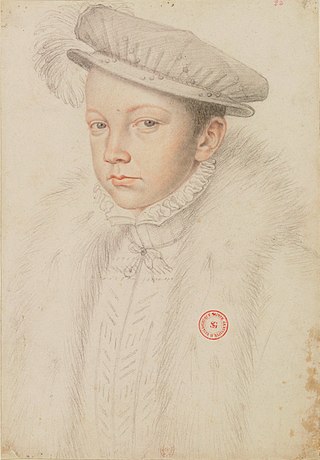
Francis II was King of France from 1559 to 1560. He was also King consort of Scotland as a result of his marriage to Mary, Queen of Scots, from 1558 until his death in 1560.
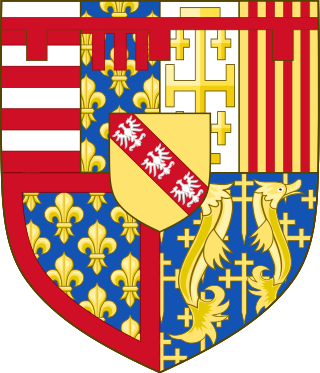
The House of Guise was a prominent French noble family, that was involved heavily in the French Wars of Religion. The House of Guise was the founding house of the Principality of Joinville.

Antoine, known as the Good, was Duke of Lorraine from 1508 until his death in 1544. Raised at the French court, Antoine would campaign in Italy twice: once under Louis XII and the other with Francis I. During the German Peasants' War, he would defeat two armies while retaking Saverne and Sélestat. Antoine succeeded in freeing Lorraine from the Holy Roman Empire with the Treaty of Nuremberg of 1542. In 1544, while Antoine suffered from an illness, the Duchy of Lorraine was invaded by Emperor Charles V's army on their way to attack France. Fleeing the Imperial armies, Antoine was taken to Bar-le-Duc where he died.
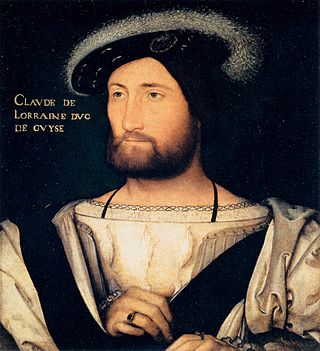
Claude de Lorraine, Duke of Guise was a French aristocrat and general. He became the first Duke of Guise in 1528.
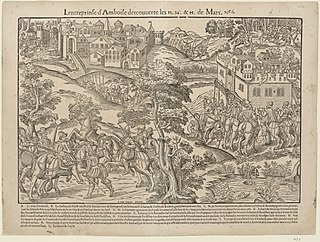
The Amboise conspiracy, also called Tumult of Amboise, was a failed attempt by a Huguenot faction in France to gain control over the young king Francis II and to reverse the policies of the current administration of Francis, Duke of Guise and Charles, Cardinal of Lorraine through their arrest, and potentially execution. Malcontent factions of Huguenots had been chafing under the French crown since the reign of Henry II and with the arrival of a new young king, saw their chance to take power for themselves. However the plot was uncovered ahead of time, and the Guise were ready for them. As such hundreds would be arrested, and many killed. Louis, Prince of Condé was suspected of involvement, however he was able to flee south, and it was only after some months that the Guise were able to put him on trial. Shortly thereafter, the sickly Francis II died, their hold on the administration collapsed, and with it the conviction of Condé. This tumult would be one of the key steps in the collapse of crown authority that led to the French Wars of Religion.

The Edict of Saint-Germain, also known as the Edict of January, was a landmark decree of tolerance promulgated by the regent of France, Catherine de' Medici, in January 1562. The edict provided limited tolerance to the Protestant Huguenots in the Catholic realm, though with counterweighing restrictions on their behaviour. The act represented the culmination of several years of slowly liberalising edicts which had begun with the 1560 Edict of Amboise. After two months the Paris Parlement would be compelled to register it by the rapidly deteriorating situation in the capital. The practical impact of the edict would be highly limited by the subsequent outbreak of the first French Wars of Religion but it would form the foundation for subsequent toleration edicts as the Edict of Nantes of 1598.
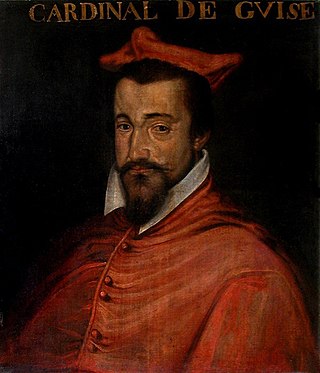
Louis II, Cardinal of Guise, was the third son of Francis, Duke of Guise, and Anna d'Este.
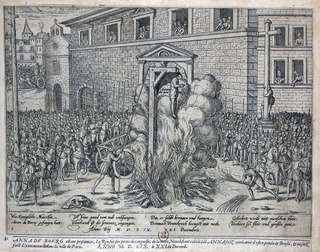
Anne du Bourg was a French magistrate, nephew of the chancellor Antoine du Bourg, and a Protestant martyr.
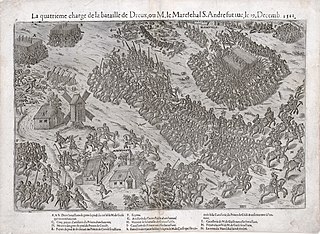
The Battle of Dreux was fought on 19 December 1562 between Catholics and Huguenots. The Catholics were led by Anne de Montmorency while Louis I, Prince of Condé, led the Huguenots. Though commanders from both sides were captured, the French Catholics won the battle which would constitute the first major engagement of the French Wars of Religion.

The siege of Rouen was a key military engagement of the first French Wars of Religion. After having been seized by those opposing the crown on 16 April, the siege, beginning on 28 May and culminating on 26 October brought the important city of Rouen back into the crowns control. The fall of Rouen would set the stage for the main battle of the war at Dreux several months later.
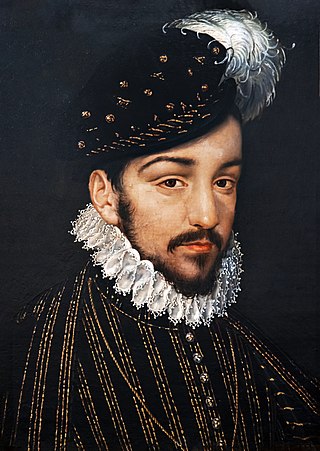
The Peace of Longjumeau was signed on 23 March 1568 by Charles IX of France and Catherine de' Medici. The edict brought to an end the brief second French Wars of Religion with terms that largely confirmed those of the prior edict of Amboise. Unlike the previous edict it would not be sent to the Parlements to examine prior to its publication, due to what the crown had felt was obstructionism the last time. The edict would not however last, and it would be overturned later in the year, being replaced by the Edict of Saint-Maur which outlawed Protestantism at the beginning of the third war of religion.

Antoinette of Bourbon, was a French noblewoman of the House of Bourbon. She was the wife of Claude of Lorraine, Duke of Guise.
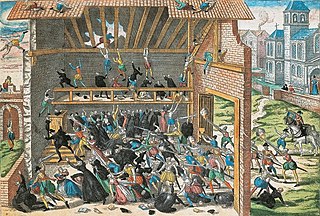
The massacre of Vassy was the murder of Huguenot worshippers and citizens in an armed action by troops of Francis, Duke of Guise, in Wassy, France, on 1 March 1562. The massacre is identified as the first major event in the French Wars of Religion. The series of battles that followed concluded in the signing of the Peace of Amboise the next year, on 19 March 1563.

The siege of Orléans was the final key military engagement of the first French Wars of Religion. Having lost the Battle of Dreux the rebel Huguenots fell back with their remaining forces to the city. Francis, Duke of Guise, the only non captive royal commander, moved to lay siege to the town, hoping its capitulation would bring about a total victory for the crowns forces. However, despite reducing the suburbs, he would be assassinated at the siege before he could bring it to a conclusion. As a result the captive Louis, Prince of Condé and Anne de Montmorency at Catherine de' Medici's direction were able to negotiate a compromise end to the first war in the Edict of Amboise.

Robert IV de La Marck, was Duke of Bouillon, Seigneur of Sedan and a Marshal of France. He rose to prominence during the reign of Henri II of France as a favourite of both the king and his mistress Diane de Poitiers. In 1547 he was elevated to the rank of Marshal of France. In 1549 he established himself as a sovereign prince, with Sedan, France granted the status of a principality. In 1552 he was granted the office of governor of Normandy, an office that historically gone to Normans or members of the royal family.

TheAssassination of the Duke of Guise by the Huguenot Jean de Poltrot at the Siege of Orléans in 1563 represents a critical turning point in the French Wars of Religion. It would be the first major assassination in what would become a blood feud between the various aristocratic houses which would see the deaths of Louis, Prince of Condé and the St. Bartholomew's Day massacre follow. It also proved a decisive factor in bringing the first War of Religion to a close in the Edict of Amboise.
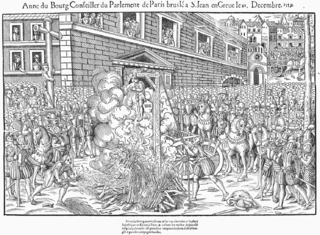
The trial and execution of Anne du Bourg was a critical event in the history of religious conflict in Paris, prior to the outbreak of the French Wars of Religion three years later. Anne du Bourg a judge in the Paris Parlement, would be executed, after calling the King Henry II an adulterer and blasphemer, and refusing to affirm the Real presence. He would be garrotted and burned on 23 December 1559. Several of his colleagues who had been arrested along with him, would be forced to recant their beliefs before returning to re-join the court. His trial would inflame religious tensions in Paris, leading directly to the assassination of President Minard, and contributing to the powder keg that exploded in the riot of Saint Medard a few months later.

The Edict of July, also known as the Edict of Saint-Germain was a decree of limited tolerance promulgated by the regent of France, Catherine de' Medici, in July 1561. Whilst it emphasised a continued commitment to banning Huguenot worship in France, it granted pardon for all religious offenses since the reign of Henry II, who had died two years earlier, which was a victory for the Protestant community. A further Protestant victory was in the reaffirmation of the removal of the death penalty for heresy cases. The edict would be overtaken by events, and ultimately left unenforced as France moved first to the landmark Edict of Saint-Germain and then into the Wars of Religion.

The Estates General of 1560-1 was a national meeting of the three estates of France, the clergy, nobility and commoners convoked by Francis II, though he would die before it could begin. It represented the first meeting of the estates general in 76 years, the last one having been convened by Charles VIII at Tours. Meeting at Orléans the estates would be tasked with providing solutions to the crowns dire fiscal problems, a legacy of the Habsburg–Valois Wars, and the growing religious problem caused by the Reformation. The estates would however be unable to finish their deliberations, with Catherine de' Medici proroguing the session, and reconvening the estates general at a later date in 1561 at Pontoise, where she sought a more agreeable selection of delegates. Ultimately the work of the estates would solve neither the crowns fiscal insolvency or the religious conflict, which exploded in the Wars of Religion.

The Edict of Amboise (1560) was a decree that created the framework to separate heresy from sedition, promulgated by the young king Francis II on the advice of his council and mother Catherine de' Medici. The edict was the first promulgated in France that lessened the persecution of Huguenots through the provision of amnesty for past religious crimes on the condition the offender returned to the Catholic fold. The edict was published during the Amboise conspiracy whilst the royal court was resident in the Château d'Amboise and their authority over France was shaken. It would be superseded first by the Edict of Romorantin in May of the same year, then the Edict of July and finally the Edict of Saint-Germain
References
- ↑ "Stuart Carroll - Department of History, University of York".
- ↑ Stuart Carroll. University of York. Retrieved 17 June 2015.